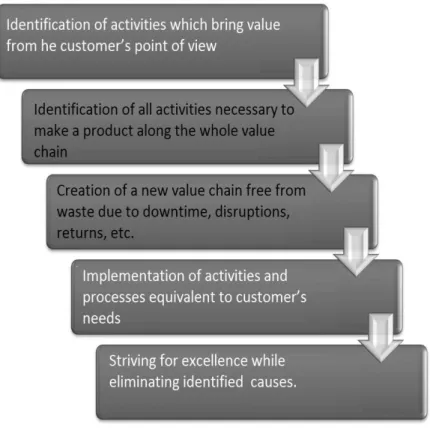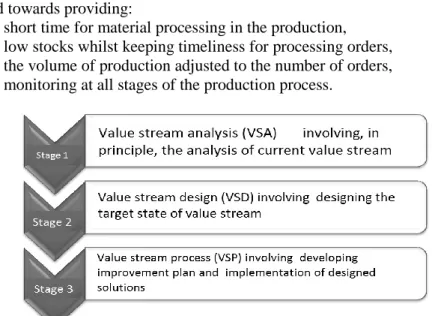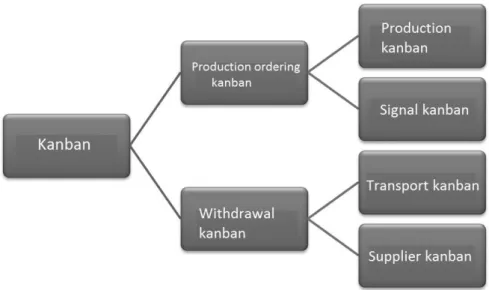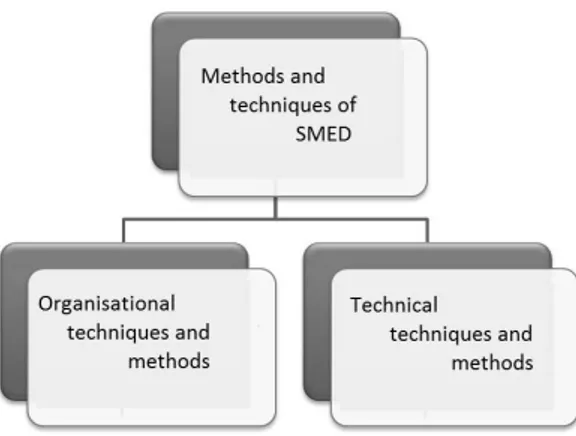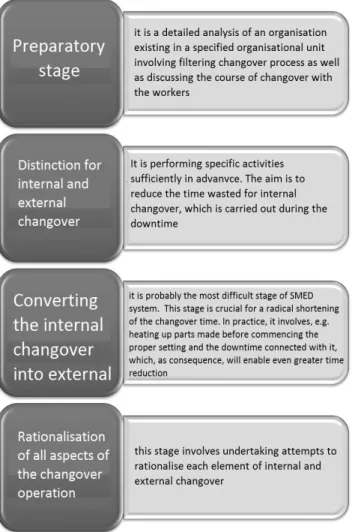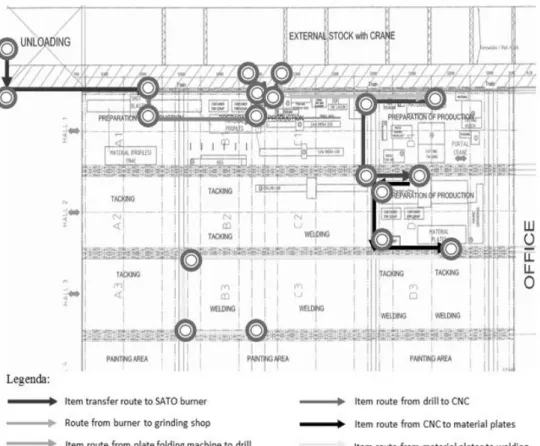IMPLEMENTING SELECTED TOOLS OF LEAN
MAN-AGEMENT IN AN ENTERPRISE WITH NON-SERIES
PROCESS
Katarzyna Topolska
WSB University in Wrocław, Email: katarzyna.topolska@wsb.wroclaw.pl
Abstract: The article focuses primarily on the implementing of selected tools of Lean Management in
the functioning of an enterprise with non-series manufacturing process. The aim is to present the possibilities of implementation of selected solutions in an enterprise which is the subject of the study. The article puts forward the essential concept of Lean Management. It contains information concerning, among other things, the specifics of this concept, the benefits of its implementation in an enterprise, and expenditure to be incurred in order to begin its practice. The paper presents selected, and at the same, basic tools used in Lean Management and includes practical aspects of the application of Lean Management in an enterprise with non-series process.
Paper type: Research Paper
Published online: 10 July 2017
Vol. 7, No. 3, pp. 247–258
DOI: 10.21008/j.2083-4950.2017.7.3.6 ISSN 2083-4942 (Print)
ISSN 2083-4950 (Online)
© 2017 Poznan University of Technology. All rights reserved. Keywords: Lean management, manufacturing process, logistics
1. INTRODUCTION
Lean Management is a concept, in principle, whose origins date back to the first years following the Second World War. Initially, it was mainly applied in the automotive sector in Japan, because of the fact that the creator of its assumptions was Toyota Motor Company (Lisiński & Ostrowski, 2006, p. 50). It should be noted at this point that due to the fact that the creator of this concept was Toyota Motor Company, in English literature it is referred to as the Toyota Production System (Junewick, 2002, p. 92).
Initially, in the 50s, the assumptions of Lean Management were used exclu-sively in Toyota Motor Company. In the 60s and 70s, the solutions developed by that company were more frequently implemented in other companies in the auto-motive sector, including (Cusumano, 1988, p. 30):
• Mazda Company; • Nissan Company; • Daihatsu Company; • Hino Motors Company.
As mentioned above, the assumptions for Lean Management concept were de-veloped just after the end of the Second World War, i.e. in the late 40s and early 50s. But it was in 1977 when for the first time an official note was given about the creation of a new management solution for a manufacturing company. This hap-pened as a result of an article published by four managers from Toyota, which was featured in the English-language magazine "International Journal of Production Research". Until then, Lean Management was not recognised outside of Japan (Su-gimori Y., 1977, pp. 553–564).
In conclusion, it should be noted that a huge rise in popularity of Lean Man-agement dates back to 1990, when a group of researchers associated with the Mas-sachusetts Institute of Technology published a book entitled 'The Machine That Changed the World', which was de facto entirely devoted to the research on the effectiveness of the use of tools forming the concept of Lean Management (Womack, Jones & Roos, 1990, p. 11).
2. LEAN MANAGEMENT IN TASKS
Lean Management is essentially a low-cost approach to management, which mainly intends to eliminate waste, and thus also to increase the added value of activities carried out within the organization.
The foundation for the deployment of Lean Management principles in an enter-prise is the ability to define waste.
The analysis of the literature allows to note that the concept of waste should be understood as any action that imposes the need to incur certain amount of work,
but does not create added value. The said value should be understood as final value for the customer (Koch, 2006). The implementation of Lean Management objec-tives in an enterprise leads to a strong demand to carry out five basic tasks, the scope of which is shown in Figure 1.
Fig. 1. The fundamental rules for the implementation of Lean Management; own study
based on (Hines, 2003, p. 8)
Lean Management is a concept which significantly differs from the traditional approach to business management. A comprehensive summary of the most impor-tant differences in this regard has been presented in table 1.
The essence of Lean Management method is the fact that it operates several dozen mutually complementary tools, the most important of which will be charac-terized in the next chapter of this article. At this point it should be noted, however, that the foundation for the implementation of any of these methods is the technique of Kaizen.
Another tool, value stream mapping, is one of the tools used in Lean Manufac-turing and is used in production logistics.
It turns out that the acceleration of time in which the flow of materials and in-formation takes place is a very important issue for logistics, especially in the area
of production, because that is where smooth execution of the manufacturing pro-cess happens. The following elements are included in this area (Rother & Shook, 2009, p. 4):
• spare parts of raw materials and intermediary products; • organization of transport within the company;
• keeping records of materials; • procedures for waste disposal.
Table 1. A synthetic summary of differences between the traditional approach to
busi-ness management and the assumptions of the Lean Management concept; Own study based on (Janiszewski & Siemieniuk, p. 58)
Item
No. Area Lean Management
Traditional approach to management
1 Organization Flat organizational structure
Military organisational structure Existence of project teams Individualism
2 Governance
The basis for the governance is formulation of a vision and
participation
The foundation of the governance in an enterprise
are orders and compulsion
3 Production
Highly qualified employees Basic qualifications of employees Cell structure Functional structure Stream production Long production cycles Zero stockholding Large amount of inventory
4 Client
High quality products Acceptable quality level of products
Customer orientation Targeting activities to generate income
The quantity of manufactured products coincident with market
demand
Make-to-stock
5 Product
development
The direction of the development of both the product and the
manufacturing process consistent with the requirements
of the client
Product development in compliance with the assumptions of the company's
employees, not taking into account the requirements of
potential customers
6 Information Broad and based on control system made by all employees
Narrowed and its source are the reports generated by
management and for management
7 Culture
Harmonious cooperation Alienation and rebellion Long-term development of
It should be added that in this area wasting resources adversely affects the per-formance of the company and causes (Rother & Shook, 2003, p. 51):
• higher than expected production costs, • increased frequency of defects occurrence, • bigger than necessary inventories,
• performing unnecessary production processes, • performing unnecessary work by employees, • downtime periods,
• manufacturing goods that do not meet customer expectations in terms of quality.
To successfully identify the structures of the processes and the links between them a method of value stream mapping is used, and especially for those activities which are responsible for the creation of added value and those that do not contrib-ute to it, because they also should be eliminated or minimized.
The advantages of value stream mapping method certainly include:
• an insight into the implemented processes in the enterprise from the begin-ning to the end of production procedures;
• analysis of all operational procedures in an enterprise.
Such a detailed analysis implies that the manufacturing process must be traced in detail, in terms of activities, but also regarding ways of information transmis-sion, because how and when the next steps are taken depends on the form of its transfer.
Therefore, the map includes information about the flow of materials and infor-mation, although the very making of it always starts with selecting the product family for which it is to be developed.
The most important stage in the course of value stream mapping is developing a mapping of the state to be achieved, because it allows to make comparison with the current state of functioning of the enterprise, as well as the identification of all possible improvements (Michlowicz & Świątoniowski, 2011, p. 29).
The map of the current status is always developed at the time of observation of the physical process flow, because it is then when the deadline is determined for the execution of scheduled tasks and waiting time, which must be allowed between the specific operations.
Mapping is a procedure performed by the team which analyses the situation of the enterprise and plans improvements, but also selects measures and indicators to evaluate the effects of work. The mapping procedure uses a set of symbols to illus-trate the material and information flows (Rother & Shook, 2003, p.54).
Value stream mapping, as is the case for other tools used within Lean Manage-ment, is characterized by multiple stages in terms of its implementation (Fig. 2).
Another tool to be deployed in an enterprise is Kanban (it is a Japanese term used to describe a signal in the form of a card). Kanban system is a tool for opera-tional production control particularly relevant in determining the current critical
path. This system is corrected by events occurring directly on the production. It is oriented towards providing:
• short time for material processing in the production, • low stocks whilst keeping timeliness for processing orders, • the volume of production adjusted to the number of orders, • monitoring at all stages of the production process.
Fig. 2. The steps for deploying VSM method in an enterprise; own study based on
(Czer-ska, 2009)
In KANBAN system all posts receive delivery schedules of finished products to customers. The appropriate staff or crew of the nest shall take the tasks. Where necessary products for production are taken from previous posts, these in turn from the posts prior to them and the initial warehouse, thus replenishing goods passed to the next position. Such a solution allows users to synchronize the flow of materials with the pace of work of all positions.
Kanban is not a homogeneous term. In daily business activities several types of Kanban can be specified, the classification of which was presented in Figure 3.
As can be clearly seen from the data presented in Fig. 3 in practice there are two main types of kanbans:
• production ordering kanban; • withdrawal kanban.
As part of the production order kanban, another two subtypes can be specified consisting of:
• production kanban, which, in principle, is used to send orders to produce small quantities in the process at the top of the stream;
• signal kanban, which is used to send orders to produce large quantities in the processes at the top of the stream producing in large lots such as em-bossing presses and injection moulding machines.
Within withdrawal kanban, as was previously in respect of production kanban, there are two subtypes of kanbans:
• transport kanban; • supplier kanban.
Fig. 3. Types of Kanban; http://lean.org.pl/kanban-sterowanie-produkcja/
Kanban, in principle, is an integral part of the enterprises functioning in accord-ance with the concepts of Lean Management and Just-in-time.
Just-In-Time is a method used for the first time by the Japanese. Its essence is to find the right materials, parts and products at the right time, in the right condition and the right amount. This method is associated with a reduction in inventories to a minimum level, synchronization of supplies with production and experience. The characteristics of this method include the continuous reduction of operating costs while maintaining high quality, elimination of defects in the process, short re-sponse time for market needs, customer orientation, great flexibility, staff training in a number of areas in order to ensure universality of activities of work cells, secu-rity of supply, close, long-term cooperation with suppliers, collaborative problem solving, ensuring the timeliness of the production and supply. „The introduction of Just-In-Time method requires: proper management of human resources (the com-petent staff incentive system, trainings), full commitment in the continuous improvement of executives and all employees, the belief of the suitability of under-taken changes, maintaining a proper sequence of implementation stages, the size of organization, possession of funds for investment, a high degree of standardization of final products/services. It is assumed that the full implementation of the Just-In-Time methods requires 5 to 7 years. The period of operation is unlimited, as
end-less improvements and reduction of losses let achieve the long-term competitive advantage” (Opolski & Modzelewski, p. 106).
Just-In-Time brings many benefits. The most important include the reduction of stock levels treated as a waste of resources, so it is possible to reduce funds frozen in inventories, improving the quality – minimizing or eliminating losses, damaged items and inappropriate work are detected and removed immediately, achieving savings by elimination of large warehouse spaces and keeping them at a minimum level, reducing the amount of transport equipment, reduction of employment, increasing the flexibility of the organization, etc. This method can be used success-fully in the material management process in any public institution.
The possible failures include failure to comply with the principle of its compre-hensive implementation in the entire organization, omission of management, ad-ministration and sales departments, too rapid reduction in stock levels, failure to make improvements, not removing the sources of problems in the institution, transport failure, unpredictability of demand, mentality and habits of staff.
3. PRACTICAL ASPECTS OF IMPLEMENTING LEAN
MANAGEMENT TOOLS IN AN ENTERPRISE WITH NON-SERIES
MANUFACTURING PROCESS
The kind of kanban which should be implemented in the studied enterprise is transport kanban.
By analysing the specifics of functioning it should be noted that the implemen-tation of improvements in the above mentioned company involving the introduc-tion of transport kanban imposes, at the same time, the need to implement the SMED method. This is determined by the fact that the product range of the unit includes more than one product, and hence, in the case of a change in the produc-tion, it is necessary to first adjust the production line to a new product.
The SMED system (Single Minute Exchange of die) is a rapid changover, and, literally, a changover in minutes. Simply put, it is a system which involves the exchange of tools in one-digit number of minutes. This system includes the meth-ods of diagnosis and improvement of the production processes in the manufactur-ing industry. The SMED method, similarly to Kaizen, was developed in Japan. It was initiated in 1950 by Shingo Shingeo, who to this day is considered to be one of the most important representatives of the Japanese science and the practice of organization and management.
As previously mentioned, the main purpose of the application of the system is a radical reduction in the duration of the changover of machines and devices. The word ‘changover’ in this case should be seen as setting the machine to replace or set tools, instruments, etc. in specific positions. The most important novelty of the
SMED system was the distinction of activities during the changovers to two basic type, namely: external changover and internal changover. As a result of the appli-cation of his own system, S. Shingo made radical changes to the changover proc-ess, which brought up to 90-percent reduction of idle time of machines. For example, the average downtime during the changover of presses, which after 1975, thanks to the SMED method was one eighteenth of the original time of this opera-tion. Other benefits achieved through the use of SMED system:
• reduction in long production series, • reduction of inventory,
• increase in the flexibility of production, • reduction of time for goods manufacturing,
• increase in productivity, so called bottlenecks of production lines, • reduction of labor costs during changovers,
• reduction of materials consumption related to changovers, • increase in the degree of equipment use,
• elimination of errors during changovers, • enhancing the quality of products, • simplification of the tools policy, • increased safety of workers,
• lowered requirements in relation to the skills of employees for changovers. The essence of the system in question provides for the application of a series of secondary techniques and methods. They can be divided into two main groups, which was identified in Figure 4.
Fig. 4. Methods used in the context of the application of the SMED system objectives; Own
study
The essence of the SMED system is also performing the largest possible num-ber of steps beyond the machine, when it is not running. Where possible, the so-called "one movement fixing" should be applied. The changover of machines also requires careful observation, in order to be able to freely register all activities.
Be-fore the changover, an employee should know which steps must be performed on the stopped machine, and which can be performed externally when the machine is running. The changover process must be designed step by step, because this will allow for quick performance. The ideal solution would be the changover without stopping the process, which is performed during the exchange of items processed in the machine. However, in reality this solution is possible more seldom than SMED, so companies would rather use the above mentioned system.
Fig. 5. Stages of changover process improvement; Own study
The SMED system is so important in the functioning of enterprises that the changover time largely determines the flexibility of production system. The shorter this time is, the smaller losses in waiting for the changover and setting machines
(machine), and so the smaller batches can be produced more profitably. It is worth adding that the reduction of machine changover time increases the time spent on production, and also reduces the amount of inventory, which is important in plan-ning. It is important to know that the key issue for the application of process im-provement methods, including SMED and methods of manufacturing inventory management is to find the optimum production costs. SMED is also important because the delays in a scheduled production process often arise from the damage to tools and machines. In addition, in companies all sorts of delays appear and they are caused by reproduction of the planning system, which does not respond to the environment with a planned horizon. Therefore, the implementation of universal methods of planning and production control (Just in time) requires risk minimiza-tion strategies in cooperaminimiza-tion with the SMED method. Therefore, the implementa-tion of SMED in manufacturing companies seems to be a necessity. Shingo, while developing SMED system, identified four key stages of improving the changover process. According to him, the implementation of SMED method is presented in Figure 5.
The SMED system uses all sorts of ancillary techniques. They include, among others:
• list of questions, • verification table, • operating test.
List of questions refers to all stages and operations necessary for the exchange of a tool. It includes a list of assignments, temperature, pressure data, numeric quantities for all measurements, as well as other parameters. Thanks to the list of questions, a double review takes place, whose goal is to detect faults in operations. The verification table is an addition to the list of questions, and allows, among others, to verify the completeness of the elements necessary to make the changover thanks to all the parts and tools specified in it.
The operating test determines the provision of confirmation on the technical condition of machines, which ensures their smooth operation.
The SMED system is one of the most significant techniques for most manufac-turing enterprises, since it refers to an important aspect of the changover time reduction. The result of a properly implemented SMED system is more than 50% reduction in the time of changovers. Each production enterprise, sooner or later, while improving all aspects of their business will face a challenge and an opportu-nity to reduce the time of the changover of devices and machines. In the era of economic development and with the desire to meet the requirements of the cus-tomer, every entrepreneur must seek solutions that will allow to meet these re-quirements. Sometimes the implementation of even simple organizational im-provements brings intangible benefits, despite the fact that they are not expensive. This kind of improvement seems to be the deployment of SMED system. The bene-fits it brings include, first of all, the reduction of inventory sites, as well as shorter deliveries, which raises customer satisfaction. Thanks to this kind of functioning
the enterprise is able to achieve a significant competitive advantage. In conclusion it is worth to emphasize that SMED system gives not only the chance to increase the value of the company, but also provides to every employee the opportunity to influence and improve their own work.
The implementation of SMED is not the only action that should precede the im-provement of production process using the assumptions of the transport kanban. In fact, it seems necessary to reorganize in-house transport. In the view of the present analysis of the in-house transport path between work sites it seems to be clear that the organization of the production process is not economical and the transport of manufactured items is too long. A lot of time is spent on the very transport of items to individual work stations and transport routes intersect.
The primary method, which, in principle, should be included in the moderniza-tion of the in-house transport path between work stamoderniza-tions is the method of the shortest route. A proposal for a new transport path was described and illustrated below. The figure also shows the places where the transport kanban cards should be applied.
4. CONCLUSIONS
Lean Management is one of the most frequently used techniques for business management, especially production enterprises. This is mainly determined by the fact that the tools used within it bring a number of benefits, the most important of which are:
• reduction in the operating costs of an enterprise;
• increase in the effectiveness of implementation of production process; • improvements in the functioning of the entire organization;
• increased safety of staff.
After analysing the specifics of the production process in the enterprise, it was concluded that it is effective, however, the implementation of additional manage-ment methods might positively influence its efficiency.
The proposal to implement the transport kanban will additionally increase the efficiency of the process.
The information presented in this article clearly show that the tools, methods and techniques used in Lean Management can significantly simplify the production process, and thus positively influence the efficiency of the functioning of the whole enterprise.
REFERENCES
Cusumano M. A. (1988), Manufacturing Innovation: Lessons from the Japanese Auto Industry, „Sloan Management Reviev”
Imai M. (2006), Gemba Kaizen. Zdroworozsądkowe, niskokosztowe podejście do zarządzania, Wydawnictwo MT Biznes, Warszawa.
Janiszewski J.M. & Siemieniuk K. (1988), Lean Management, jako koncepcja wspomagająca zarządzanie innowacjami w przedsiębiorstwie, Stowarzyszenie Wrota Przedsiębiorczości, WNEiZ.
Junewick M.A. (2002), LeanSpeak. The Productivity Business Improvement Dictionary, Productivity Press, New York.
Koch T. (2006), Materiały konferencyjne: VI Konferencja Lean Manufacturing, Oficyna Wydawnicza Politechniki Wrocławskiej, Wrocław.
Lisiński M. & Ostrowski B. (2006), Lean Management restrukturyzacji przedsiębiorstwa, Wydawnictwo Antykwa, Kraków – Kluczbork.
Michlowicz E. & Świątoniowski A. (2011), Doskonalenie ciągłości przepływu metodą mapowania VSM, AUTOMATYKA, tom 15, zeszyt 2, Wrocław.
Rother M. & Shook J. (2009), Naucz się widzieć, LEI Polska, Wrocław.
Rother M. & Shook J. (2003), Naucz się widzieć. Eliminacja marnotrawstwa poprzez mapowanie strumienia wartości. Wrocławskie Centrum Transferu Technologii, Wrocław, pp. 4-54.
Sugimori Y., et. al. (1977), Toyota production system and Kanban system Materialization of just – in – time and respect – for – human system, „International Journal of Production Research”, Vol. 15, pp. 553 - 564
Womack J.P., Jones D.T. & Roos D. (1990), The Machine that Changed the World, Rawson Associates, New York.
http://www.strefa-iso.pl/pl,artykuly,iso-podejscie-procesowe-2 http://lean.org.pl/kanban-sterowanie-produkcja/
BIOGRAPHICAL NOTES
Katarzyna Topolska PhD in technical sciences awarded in 2007. Employed in
WSB University in Wrocław at the position of Assistant Professor in the Institute of Logistics. Head of Department of Logistics engineering studies. Specialist in the design of logistics processes. Longtime coach in national and international companies. Experience in modeling logistic processes with the use of information systems – Anylogic, FlexSim.
